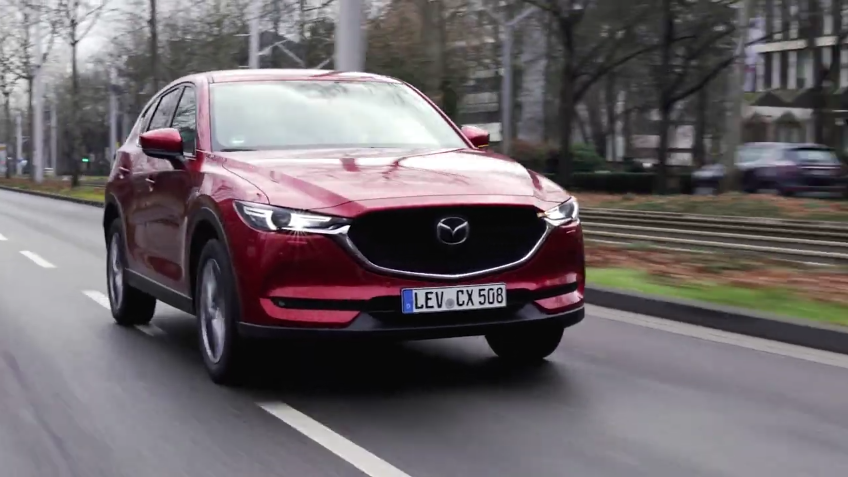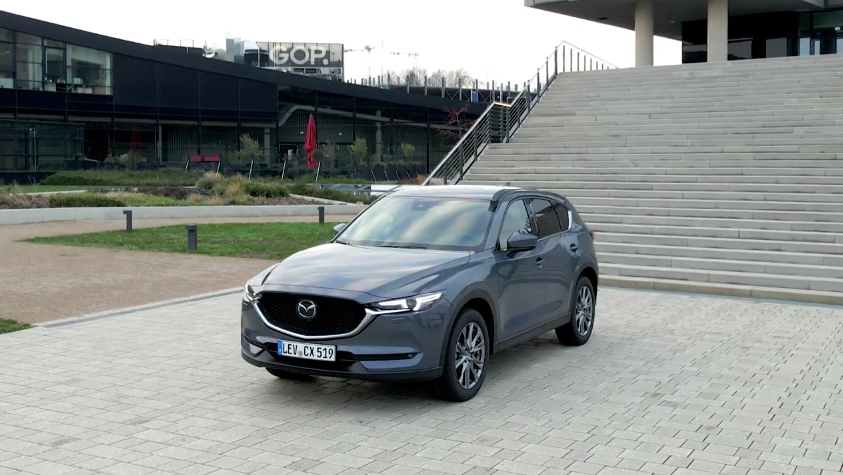A Comprehensive Review of Mazda CX-5 (2012-2017)
In Shorts:
- Well-liked little crossover recognized for its sporty handling, smooth ride, cozy seats, well-equipped interior, and safety ratings.
- 2016 saw design updates for the infotainment system, suspension tuning, and automated parking brake.
- bigger door pockets, a more comfortable backseat, and adjustments to the seat-bottom cushion.
Within five years, Mazda remade itself. Today, the brand’s goods emphasize design, efficiency, and technology while focusing on customer happiness. 2012 Mazda introduced the 2013 Mazda CX-5 small, 5-passenger crossover SUV, starting its metamorphosis. The CX-5 introduced the automaker’s Kodo design language and a new SkyActiv engine line that enhances gas consumption without sacrificing performance. After four years of production, the Mazda CX-5 receives various upgrades to improve its design, usefulness, technology, and driving characteristics.
Mazda CX-5 Specifications

| Engine Type | Gas |
| Transmission | 6-speed shiftable automatic |
| Drive Type | All wheel drive |
| Cylinders | Inline 4 |
| Total Seating | 5 |
| Basic Warranty | 3 yr./ 36,000 mi. |
| Fuel type | Regular unleaded |
| EPA city/highway MPG | 24/30 MPG |
| EPA combined MPG | 26 MPG |
| Range in miles (city/hwy) | 367.2/459.0 mi. |
| Fuel tank capacity | 15.3 gal. |
Vehicle Overview
Compact crossover SUVs are popular for their luggage space, fuel economy, higher driving positions, and bad weather competence—one of the most popular automobile categories. The 2016 Mazda CX-5 is one of our favorites in that crowded class. This Mazda leads the class with its well-trimmed cabin, great safety ratings, smooth and quiet ride, comfy seats, and superb visibility. The CX-5’s tight steering and lively handling make driving pleasurable and unique in this class. The CX-5’s larger engine, standard on most trim levels, delivers strong performance and fuel economy. Whether traveling to work, conducting errands, or dropping off the kids, the 2016 Mazda CX-5 is as fun and comfy as your favorite jeans. Those qualities make the CX-5 a wonderful road trip companion.
Mazda tweaked the CX-5 for 2016. Design changes to the front and back, an automatic parking brake, sound insulation to decrease road noise, an upgraded infotainment system, and suspension tuning for a more pleasant ride. Larger door pockets and console bins increase cabin storage. Mazda also increased the backseat’s seat-bottom cushion.
The basic 2.0-liter engine on the Sport trim level with the manual gearbox is the biggest weakness of this otherwise great package. Despite its fuel efficiency, it has little power and little benefit over the 2.5-liter engine. We recommend the 2.5-liter engine for large passenger loads and mountainous driving. In addition, Mazda CX-5 sound systems are poor. Audio quality is poor even with the top Bose system. There are several decent compact crossovers, so compare them before buying.
Honda CR-Vs are spacious, well-appointed, and easy to drive. Though less sporty than the CX-5, it’s still a good pick. The Ford Escape sports a luxurious cabin and a turbocharged engine. The Toyota RAV4 has a spacious interior and is comfortable on the highway. Consider the Jeep Cherokee or Subaru Forester for a tiny crossover SUV that can go off-road. Each of these rivals has benefits, but the 2016 Mazda CX-5 is one of the best vehicles in this market and should be considered.
Performance & Mpg

Two engines power the 2016 Mazda CX-5 Sport, which is front-wheel-drive. You may pick a 2.0-liter four-cylinder engine with 155 horsepower and 150 pound-feet of torque with a six-speed manual gearbox or a 2.5-liter engine with 184 hp and 185 lb-ft and an automated gearbox. All-wheel drive is offered on 2.5-liter Sport versions. The larger engine is standard on Touring and Grand Touring. According to the EPA, the 2.0-liter Sport FWD gets 29 mpg combined (26 city/35 highway). The 2.5-liter engine in all FWD CX-5s gets 29 mpg combined (26/33), while the AWD ones get 26 (24 city/30 highway). According to Edmunds, a 2.5-liter CX-5 with AWD sped from 0 to 60 mph in 8.0 seconds, which is good for its class.
Mazda CX-5 2016 Safety
Antilock brakes, stability, traction control, and front side and side curtain airbags are standard on every 2016 Mazda CX-5. Automatic collision notification is optional on the Sport but standard on the Touring and Grand Touring, which have blind spot and rear cross-traffic warning systems. The Touring and Grand Touring’s Smart City, Brake Support technology employs a laser sensor to identify stopped automobiles and pedestrians at speeds up to 19 mph. The CX-5 may brake autonomously if the driver ignores a warning. The i-ActiveSense package adds adaptive cruise control, Smart Brake Support, lane departure warning, and automatic high beam control to the Grand Touring.
The optional Mazda Mobile Start smartphone software may lock automatic CX-5 doors remotely. Edmund brake testing showed a CX-5 Grand Touring stopped from 60 mph in 121 feet, which is better than average for the class. In government crash testing, the CX-5 scored four stars for overall crash protection, four for frontal-impact protection, and five for comprehensive side-impact protection. The Insurance Institute for Highway Safety (IIHS) gave the CX-5 the highest possible ” Good “ grade in moderate-overlap frontal-offset, small-overlap, side-impact, and roof-strength tests. Rear whiplash protection graded “Good” with its seat/head restraint configuration.
Mazda CX-5 2016 Driving
Despite its standard 2.0-liter engine’s competitive power, the Mazda CX-5 feels weak during merging and passing maneuvers. The 2.5-liter four-cylinder is better for most compact crossover buyers given its stronger power and nearly comparable fuel efficiency. The six-speed automatic shifts smoothly and rapidly, making it one of the most responsive in this class. Mazda still manufactures a fine manual gearbox, but only with the 2.0-liter engine, limiting its appeal. Athleticism is the 2016 Mazda CX-5’s standout feature. Even if you’re only looking for a compact crossover to go to work, its steering, brakes, and suspension are impressive. The CX-5 is pleasant to drive and entertaining on winding roads. The Mazda rides as comfortably as most crossovers on the interstate, making it a good road trip companion.
Mazda CX-5 2016 Interior
The Mazda CX-5 interior is stylish, contemporary, and useful regardless of model level. The sophisticated design excludes poorly rendered imitation wood or excessively shiny chrome trim. Materials are basic and high-quality, and soft-touch surfaces have subtle metallic or piano black accents. Black gauges with white text are legible on the CX-5. The 2016 CX-5 has better infotainment. The new system is one of the best, with a 7-inch screen (up from 5.8-inch) and an easy multifunction control knob.
On extended road journeys, front-seat comfort is great; most drivers can find a decent driving posture. Mazda upgraded the 2016 CX-5’s infotainment. The Mazda’s backseat has ample space for its class. On Touring and Grand Touring trim levels, the rear seat’s revolutionary folding mechanism lowers the seat bottom and folds the seatback to create a near-flat cargo floor. With all seats filled, baggage space is 34.1 cubic feet. Folding the back seats increases space to 64.8 cubic feet, which is competitive.
Mazda CX-5 2016 models

The five-passenger 2016 Mazda CX-5 comes in Sport, Touring, and Grand Touring trims. FWD or AWD is available on all model levels. Base Sport with the 2.0-liter engine and manual gearbox comes standard with 17-inch alloy wheels, full power accessories, air-conditioning, cruise control, height-adjustable driver seat, tilt-and-telescoping steering wheel, 60/40-split folding rear seat, Bluetooth phone, and audio connectivity and a four-speaker sound system with CD player, auxiliary audio jack and iPod/USB interface.
Sport models have a 2.5-liter engine and automated gearbox. The standard features include a 7-inch touchscreen interface, multifunction controller knob, HD radio, Pandora Internet radio, automated crash notification, SMS text message reading, and audio system voice commands. Rearview cameras are standard on the 2016.5 model but optional on the 2016. The Touring adds foglights, keyless ignition and entry, blind spot and rear cross-traffic warning systems, a six-way power driver seat, a height-adjustable passenger seat, a 40/20/40-split folding rear seat, upgraded cloth upholstery, a leather-wrapped steering wheel, and a six-speaker sound system. A sunroof and nine-speaker Bose audio system are included with the Moonroof and Bose Audio option package. The Grand Touring adds 19-inch wheels, automatic headlights, windscreen wipers, heated mirrors, dual-zone automatic temperature control, satellite radio, heated front seats, and leather upholstery.
Wheel and Steering
The steering wheel is hot—not ideal. It’s leather, but I’m not sure if it’s real. It makes my hands sweat even at mild temps; thus, I think it’s fake. That makes it stick. I never sweated with my prior car’s leather wheel. The wheel grips better. Perfectly formed and proportioned, athletic. Too little padding for my tastes. One-handed twists hurt and need more pressure. A squarish cross-section doesn’t help.
The steering is well-balanced, light at low speeds, and hefty at hundreds. Good road feel for an SUV. I despise on-wheel controls. I prefer stalks. They are easier to handle and can be done without looking. Mazda engineers didn’t spend much time establishing a tactile, intuitive formula for button placement, functionalities, and findability, which is unfortunate. You keep looking for buttons and losing focus on the road. The trip computer screen only shows one thing at a time, forcing you to hit the steering wheel controls more often than with a larger screen.
The Engine and Gearbox
There are several articles about the high-compression Mazda engine technology. The engine works nicely. Outstanding for a non-turbo engine. Its torque allows it to sustain pace on a steep road even at low RPMs (below 1500, down to 1100-1200) and to upshift early to save gasoline. The engine sound is good for a 4-cylinder, but the exhaust noise is severe. To further understand the exhaust, see below. When pressed, the car downshifts instantly. It can skip gears, going from sixth to fourth to save time. A naturally aspirated petrol will occasionally drop to fourth on an uphill roadway, but it usually stays in fifth or sixth due to its torque. Power is sufficient for overtaking and large loads, but it won’t give you the crumpled-seat feeling of a true power engine. Only seldom have I had to kick down. I mostly do it for enjoyment.
| Pros | Cons |
| Well-trimmed cabin | The base 2.0-liter engine lacks power |
| Great safety ratings | Poor audio quality in sound systems |
| Smooth and quiet ride | Limited appeal of a manual gearbox with a 2.0L engine |
| Comfortable seats | |
| Superb visibility | |
| Lively handling and tight steering | |
| Improved design and infotainment |
Should I Buy The 2016 Mazda CX-5?
The 2016 Mazda CX-5 should continue to excite buyers. Mazda has improved its small crossover SUV in subtle and significant ways, making it appear and feel like a value even at sticker price. Comparing crossovers and automobiles sometimes reduces driving enjoyment, but not always. However, the CX-5’s failure to match its official EPA city fuel-economy rating, let alone its combined driving rating, and the NHTSA’s inexplicable crash protection reduction are more troubling. CX-5 ownership should be rewarding if purchasers are prepared to overlook these faults and try to set up and learn how to utilize the Mazda Connect infotainment system.
FAQs
Q: What sets the Mazda CX-5 (2012–2017) apart in the crossover market?
The Mazda CX-5 stands out in the crossover market with its dynamic handling, smooth ride, comfy seats, well-equipped cabin, and high safety ratings.
Q: What changed in the 2016 Mazda CX-5?
The 2016 Mazda CX-5 received front and rear design tweaks, an automated parking brake, infotainment system upgrades, and suspension tuning. Larger door pockets, a more comfortable backseat, and seat-bottom cushion modifications were also included.
Q: How does the 2012–2017 Mazda CX-5 handle performance and fuel efficiency?
The 2016 Mazda CX-5 has two engines: a 2.0-liter four-cylinder and a 2.5-liter. The conventional bigger engine on most trims performed better and got equivalent fuel economy. CX-5 prioritized smooth, responsive driving.

















